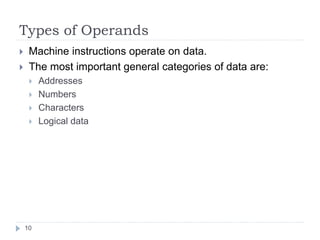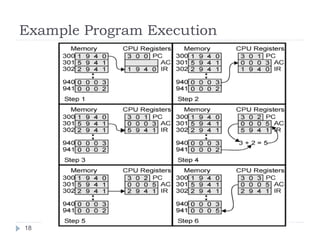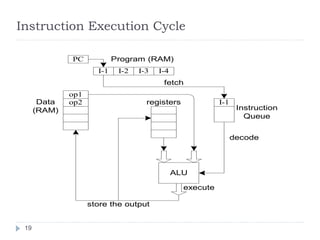Processor Basics
- 1. CSC 222: Computer Organization & Assembly Language 5 – Processor Basics Instructor: Ms. Nausheen Majeed
- 2. Outline Basic Operational Concepts Processor Clock Instruction Representation Instruction Cycle 2
- 3. References Chapter 1, Ytha Yu and Charles Marut, “Assembly Language 3 Programming and Organization of IBM PC” Chapter 3, William Stallings, “Computer Organization & Architecture” Chapter 2, Subrata Ghoshal, “Computer Organization & Architecture”
- 5. Machine Instruction Elements Each instruction must have elements that contain the information required by the CPU for execution. These elements can be: 5 Operation code: Specifies the operation to be performed (e.g.. ADD, I/O). The operation is specified by a binary code, known as the operation code, or opcode. Source operand reference: The operation may involve one or more source operands, that is, operands that are inputs for the operation. Result operand reference: The operation may produce a result. Also called destination operand. Next instruction reference: This tells the CPU where to fetch the next instruction. Reference: http://cnx.org/content/m29425/latest/
- 6. Instruction Representation Within the computer, each instruction is represented by a sequence of bits. 16 bits instruction 6 4 bit opcode, 6 bit operand 1, 6 bit operand 2 4 bit opcode, 12 bit operand 32 bits instruction 64 bits instruction Figure: A Simple Instruction Format
- 7. Contd.. Binary representations of machine instructions is difficult to remember. Use a symbolic representation of machine instructions. Opcodes are represented by abbreviations, called mnemonics, that indicate the operation. Common examples include: 7
- 8. Instruction Types Data processing: Arithmetic and logic instructions Data storage: Memory instructions Data movement: I/O instructions Transfer of Control: Test and branch instructions 8
- 9. No. of Addresses in an Instruction Three addresses 9 Operand 1, operand 2, result Two addresses Source Destination One addresses Source or Destination Zero address Zero-address instructions are applicable to a special memory organization, called a Stack. A stack is a last-in-first- out set of locations.
- 10. Types of Operands Machine instructions operate on data. The most important general categories of data are: Addresses Numbers Characters Logical data 10
- 11. Basic Operations – Processor Execute the software by fetching instruction from memory Look for any external signal and react accordingly Input signals from keyboard or mouse etc. 11
- 12. Processor Clock Heart of any processor Simple digital signals at equal time intervals Alternate On Off states All activity within the CPU is synchronized with the edges (rising or falling) of this clock signal. Rising Edge Falling Edge Reference: http://www.plantation-productions. 12 com/Webster/www.artofasm.com/Linux/HTML/SystemOrganizationa4.html
- 13. Program Counter (a.k.a. Binary Counter) With every falling edge or rising edge (depending upon processor) of clock signal, the counter is incremented by one. Width varies from processor to processor The contents of PC are used as target address for the memory area 13 Microprocessor Read Address Memory Control Unit (CU) PC Data Buffer Memory Read Memory address Data from Memory Data Figure: Reading from memory
- 14. Basic Instruction Cycle Fetch Decode Execute Fetch 1. Fetch an instruction from memory 2. Decode the instruction to determine the operation 3. Fetch data from memory if necessary Execute 4. Perform the operation on the data 5. Store the result in memory if needed 14
- 15. Contd.. Internal CPU Registers used in instruction cycle: Program Counter (PC) = Address of instruction Instruction Register (IR) = Instruction being executed Accumulator (AC) = Temporary Storage 15
- 16. Computer Components: Top Level View Contd.. 16
- 17. Detailed Steps Address in the Program Counter register Program Counter (PC) holds address of next instruction to fetch Fetch the instruction from the memory Increment the Program Counter Unless told otherwise Instruction loaded into Instruction Register (IR) Decode the type of instruction Fetch the operands Execute the instruction Store the results 17
- 18. Example Program Execution 18
- 19. Instruction Execution Cycle PC Program (RAM) I-1 I-2 I-3 I-4 I-1 Instruction Queue op1 Data op2 (RAM) fetch registers ALU store the output decode execute 19
- 20. Instruction Cycle State Diagram 20
- 21. Contd.. Instruction Fetch Read instruction from memory into processor Instruction Operation Decoding Determine the type of operation to be performed and 21 operand(s) to be used. Operand Address Calculation If operation involves reference to an operand in memory or I/O, then determine the address of operand. Operand Fetch Fetch from memory or read from I/O Data Operation Perform the operation Operand Store Write into memory or out to I/O if required





















